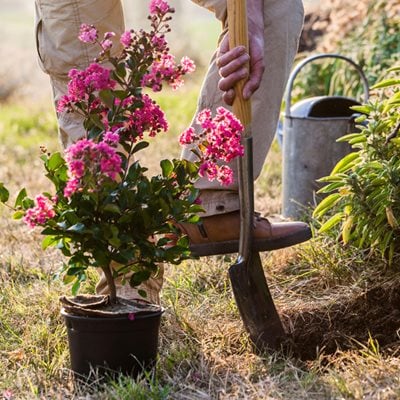Where To Learn How To Garden

Photo by: BIOSPHOTO / Alamy.
Gardening is about finding the right combination of sunlight, fertile soil, and water to make your plants thrive. It's also about fulfilling your passion, so select plants you love. Use the resources here as a starting point, and in no time you'll have a beautiful garden, no matter what level of gardening experience you have.
On this page:
- GARDENING BASICS
- GARDEN PESTS, PLANT DISEASES, & OTHER PROBLEMS
- HOW TO GROW ANNUALS, PERENNIALS, SHRUBS, BULBS
- HOW TO GROW VEGETABLES & HERBS
- HOW TO GROW GORGEOUS FLOWERS
- HOW TO GARDEN INDOORS
- GARDEN-INSPIRED DIY PROJECTS
- COMMON GARDENING TERMS
GARDENING BASICS
Beginning gardeners are often intimidated by the process of how to start a garden and care for it successfully—after all, there's a lot involved. From amending your soil with high-quality organic matter to pruning shrubs, you'll find answers and advice for essentail gardening tasks.
PESTS, DISEASES, & OTHER GARDEN PROBLEMS
Learn how to safely and naturally deal with common pests, diseases, and weeds that can wreak havoc on your garden.
See more: Garden Pests, Plant Diseases, & Other Garden Problems
HOW TO GROW ANNUALS, PERENNIALS, SHRUBS, BULBS
Learn how to grow different types of plants and their uses in the garden. Understand the differences between them and what growing conditions they do best in.
HOW TO GROW VEGETABLES & HERBS
Many beginning gardeners find the process of growing their own food rewarding, and not as difficult as they anticipated. Whether you're looking to start with just a few tomatoes or you're planning to create a full-fledged kitchen garden, doing your homework on how to plant, care for, and harvest your crops will be valuable.
See more: Vegetable Garden Ideas, Design, & What to Grow
HOW TO GROW GORGEOUS FLOWERS
Starting a flower garden doesn't have to be daunting—whether you choose to grow from seed or young plants. Plan your own flower garden, get suggestions for easy-to-grow flowers, and soon you'll have lovely flowers everywhere.
HOW TO GARDEN INDOORS
When winter arrives, your gardening doesn't have to stop. Try your hand at growing a few plants indoors and you'll find that it isn't too hard. Learn how to keep your houseplants happy with proper care and placement.
GARDEN-INSPIRED DIY PROJECTS
Looking for a fun project? Get how to info for using flowers, branches, and other items from your garden to create clothing, décor, and more.
COMMON GARDENING TERMS
Basic Types of Plants:
- Annual: Plants that grow, flower, set seed, and die all in one growing season
- Perennial: Plants that come back year after year; some are evergreen, some are deciduous
- Shrub: Woody plants that have several main stems; some are evergreen, some are deciduous
Evergreen: Plants that do not go dormant and keep their leaves through winter
Deciduous: Plants that go dormant and drop their leaves in winter
Zone: There are 11 different growing zones in the U.S. and Canada based on the lowest average temperature each area receives during winter. Knowing what zone you are gardening in allows you to pick plants that will withstand the coldest expected temperature for your area. Read more: Zoning in on Hardiness.
Exposure: The amount of sun or shade a plant needs
- Full sun: 6 or more hours of direct sunlight each day
- Partial sun/shade: 4 to 6 hours of direct sunlight each day
- Full shade: Less than 4 hours of direct sunlight each day
- Dappled shade: A mixture of sun and shade, usually under an open tree; similar to partial shade
Habit: Refers to the general structure or shape of the mature plant
- Climbing: Plants that climb fences, trellises, or structures (i.e., vines)
- Clump forming: Plants that form clumps of foliage, often spreading to form more clumps
- Mounded: Plants with a rounded shape, usually wider than tall
- Spreading: Plants that are low-growing and spread along the ground, rooting at nodes along the stem
- Trailing: Plants that trail along the ground or cascade out of containers, but do not root from the stem
- Upright: Plants that are taller than wide, with generally straight sides
Height & spread: The estimated size of a mature plant
First or last frost date: The average date for your area for the first frost in fall or the last frost in spring
Native: A plant that has grown naturally over hundreds or thousands of years in a particular area. These plants are well adapted to their native growing conditions (soil, climate, water, etc.) and are beneficial to their local pollinators and wildlife.
Invasive: A non-native plant that becomes established in an area outside it's native region and spreads rapidly, to the point of disrupting the native environment and ecosystem.
For more common gardening terms, see this Dictionary of Gardening Terms from Proven Winners.
Where To Learn How To Garden
Source: https://www.gardendesign.com/how-to/
Posted by: myersborceir.blogspot.com

0 Response to "Where To Learn How To Garden"
Post a Comment